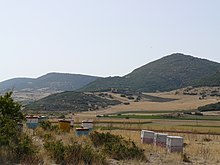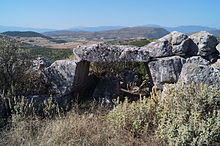Abai (Greece)
Abai ( Greek Ἄβαι ; Latin Abae ) was an ancient Greek city in the northeast of the Phocis region . She was on her Apollon - Oracle announced that the Lydian king Croesus and by the Thebans before the battle of Leuctra (371 BC..) To have been consulted. The temple was built in 480 BC. By the Persians and 352 BC. Burned down during the Third Holy War and partially restored by the Roman Emperor Hadrian . Remains of the surrounding wall and the acropolis are still preserved from the former city .
location
Abai is identified with the small ruins 2.5 kilometers west of today's Exarchos and 10 km southwest of Atalanti . The site is located in an eastern side valley of the Assos River on the 431 meter high Kastro hill , which towers over the plain by about 160 meters. Abai was on the road from Orchomenos to Opus. The famous Apollo shrine at Abai was about 6.5 kilometers north of the town of Kalapodi . The ruins of the ancient city of Hyampolis are 2.5 kilometers west of Abai.
history
According to local tradition, Abai was named after its mythical founder Abas , King of Argos. Aristotle , however, attributes the founding of the city to Thracians . Abai became known through an old oracle sanctuary of Apollo , which is located outside the city walls , of which only small remains exist. This oracle is said to have been consulted by Croesus , the last king of Lydia , and by the Thebans before the battle of Leuctra (371 BC). Due to the many invocations it was in the 5th century BC. Rich in votives - such as B. Shields and statues donated by the Phokers. The temple was built in 480 BC. During the Persian Wars by the Persian King Xerxes I and 352 BC. Destroyed by the Thebans in the Third Holy War and has been in ruins ever since. The Roman Emperor Hadrian had another, somewhat smaller Temple of Apollo built next to the old sanctuary, in which statues of Apollo, Latona and Diana were placed.
The city itself was founded in 480 BC. By Xerxes I and 352 BC Taken by the Thebans. The Macedonian King Philip II spared them in 346 BC. Because only they - in contrast to all other Phocian cities - did not participate in the attack on the sanctuary of Delphi during the Third Holy War . In 208 BC After all, Abai was attacked by the Macedonians under Philip V ; the oracle, however, remained tax-free. During the Hellenistic period, Abai was overtaken in importance by the nearby Hyampolis. In Roman times, Abai was autonomous as a holy city.
exploration
The English archaeologist William Martin Leake was the first to identify Abai and describe the site. In the spring of 1894, the British School at Athens conducted archaeological excavations under the direction of AG Bather and VW Yorke.
description
The Acropolis of Abai was at the top of the mountain, which is easily accessible from the west and south and slopes steeply to the north and east. It was almost completely surrounded by a polygonal wall , only in the east on the steepest section it is missing. A second wall surrounded this - it ran from the east of the acropolis about 100 meters to the south, it turned to the west about parallel to the acropolis wall to end running north at the western acropolis. The outer city wall included a mountain saddle and part of the fertile plain in the north; the ruins of numerous ancient buildings were found here. The southern part of the outer fortification was provided with projections and in the southeast a well-preserved gate was found, which was reinforced with a tower. There is still no trace of the agora and theater mentioned by Pausanias. All the walls that have been preserved are made in the polygonal style and date from the 6th / 5th centuries. Century BC And are made of limestone that was quarried on site. The walls are 2–2.5 meters thick and are still 1–3 meters high today. The inner and outer facade of the wall was built from large stones and filled inside with rubble and small stones.
A sanctuary from the 4th century BC was found on a low hill about 700 meters to the southwest. With an approximately 30 meter long stoa and two small temples. Leake and Yorke suspected that this would be the famous Apollon sanctuary of Abai. In the necropolis on the hillside west of the sanctuary, rare bronze objects from the Hellenistic-Roman period were found, as well as imported Corinthian and Attic ceramics and terracotta.
From 1972 to 1982 an excavation by the German Archaeological Institute took place under the direction of Rainer Felsch in the Apollon shrine near Kalapodi. From 2004 to 2013 this excavation was continued by Wolf-Dietrich Niemeier and a total of six different temples were uncovered. With the excavation the continuity theory of Martin Persson Nilsson could be rehabilitated and a trace to the temple of Apollon was found. According to this latest state of research, this sanctuary is the Sanctuary of Apollo at Abai.
literature
- Gustav Hirschfeld : Abai . In: Paulys Realencyclopadie der classischen Antiquity Science (RE). Volume I, 1, Stuttgart 1893, Col. 11.
- Ernst Kirsten : Abai. In: The Little Pauly (KlP). Volume 1, Stuttgart 1964, Col. 2.
- Frederick Eliot Winter: Abai Phokis, Greece . In: Richard Stillwell et al. a. (Ed.): The Princeton Encyclopedia of Classical Sites. Princeton University Press, Princeton NJ 1976, ISBN 0-691-03542-3 .
Web links
Remarks
- ^ Pausanias 10:35 , 1-5.
- ^ Pausanias 10, 35, 1.
- ^ Aristotle, fragment in Strabo 10, 1, 3 p. 445.
- ↑ Herodotus 1:46; 8, 27; 8, 33; 8, 133; Pausanias 10, 35, 1-5; Strabon 9, 3, 13 p. 523; Diodorus 16, 58, 3-6.
- ↑ Herodotus 1:46.
- ^ Pausanias 4:32 , 5.
- ↑ Cf. e.g. Herodotus 8:33; Sophocles , King Oedipus 899; Strabon 9, 3, 13 p. 523.
- ↑ Herodotus 8:27 .
- ↑ a b Herodotus 8:33.
- ↑ Pausanias 10:35 , 3; Diodorus 16:58; Eusebius , Praeparatio evangelica 8, 14; About 500 Phocaeans who fled to the temple are said to have died in the fire - either intentionally set or (according to Diodorus) accidentally spread there.
- ^ Pausanias 10:35 , 3.
- ^ Pausanias 10: 3, 2.
- ↑ Inscriptiones Graecae 9, 1, 78; Wilhelm Dittenberger: Sylloge inscriptionum Graecarum , 3rd edition 1915-1924, 552.
- ^ William Martin Leake: Travels in Northern Greece , Volume 2, pp. 163–166 ( online )
- ^ VW Yorke: Excavations at Abae and Hyampolis in Phocis . In: The Journal of Hellenic Studies 16, 1896, pp. 291-312 ( online ).
Coordinates: 38 ° 34 ′ 49 ″ N , 22 ° 54 ′ 58 ″ E



